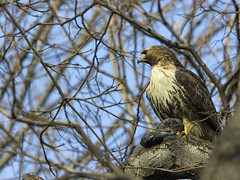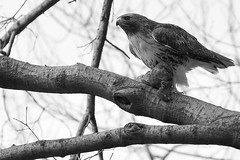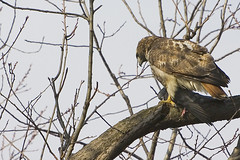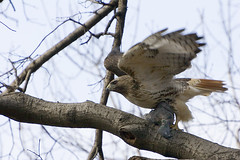| Author | Thread |
|
|
02/03/2006 12:45:31 AM · #1 |
Saw this dude in NYC today. Can anyone ID him (her) for me?
 
|
|
|
|
02/03/2006 12:56:35 AM · #2 |
| Looks like a Swainson's Hawk. But I'm not an expert and could be wrong. |
|
|
|
02/04/2006 10:51:01 AM · #3 |
Thanks lepidus!
Here are two other shots of the same bird - anyone else know?
 
|
|
|
|
02/04/2006 10:57:02 AM · #4 |
Not so sure...Looks more like a red-tailed to me
|
|
|
|
02/04/2006 11:08:23 AM · #5 |
Looks like a Juvenile Northern Harrier(Circus Cyaneus)
MORE INFORMATION
MEASUREMENTS: The Northern Harrier has a body length of 17 - 24 inches, a wingspan of 3 1/2 - 4 1/2 feet, and weighs 12 - 18 ounces. The female bird is quite a bit larger than the male.
HABITAT: Northern Harriers reside in North America, Europe, and Asia, and prefer open country, like grasslands, steppes, wetlands, meadows, cultivated areas, and tundra. Birds in the northern part of the range migrate south.
DIET: This hawk eats small mammals, birds, reptiles, insects, and carrion. Harriers hunt using a low, slow flight over the ground, then plunge onto their prey.
REPRODUCTION: Northern Harriers nest on the ground in thick grass, shrubbery, or other vegetation. The nest is a pile of sticks and grass. The female lays 3 - 6 eggs depending on the abundance of small rodents. The eggs are incubated 29 - 31 days, and the young hawks fledge 4 - 5 1/2 weeks later. Harriers mature in 2 - 3 years, but may be able to breed their first year.
NAME DERIVATION: The scientific name comes from the Greek words kirkos, meaning a circle and refers to flying in circles, and cyan, a blue color alluding to the color of the male bird. Harrier is from the Old English word hergian, and means to harass, ravage, or plunder. This bird has also been called a Marsh Hawk or Hen Harrier.
INTERESTING FACTS:
Harriers roost and nest on the ground, often in groups in a traditional location. They are often polygynous, with a single male mating with 2 - 3 or more females. This may be a result of colonial breeding.
Unlike most hawks, harriers can use their sense of hearing to help locate prey. Harriers have an owl-like facial disk to help with directional hearing and soft feathers for a quieter flight.
Many birds of prey utilize display flights during courtship. The male Northern Harrier’s courtship flight is a series of dramatic “barrel rolls” over his territory.
|
|
|
|
02/04/2006 11:09:38 AM · #6 |
Looked it up in my Audubon Society Field Guide to Birds
It looks like a Red Tailed Hawk about 18 to 24 inches tall. I know there is a building on Central Park West where a couple are nesting.
Hope that helps.
Michael.
|
|
|
|
02/04/2006 11:13:14 AM · #7 |
| If these photos were from NYC Central Park the bird may belong to the family of Red Tail Hawks featured in this film that played on PBS: //www.palemalethemovie.com/ |
|
|
|
02/04/2006 11:18:36 AM · #8 |
Here is some links you decide for yourself:
Northern Harrier
Red Tail
Enjoy
|
|
|
|
02/04/2006 11:31:05 AM · #9 |
Wow! A lot of responses. Thanks for the info, everyone. I saw it flying over Riverside Drive more than a mile from the "famous" CPW Hawks. I've seen similar large birds roughly this time of year around the same spot before (near the Soldiers and Sailors monument.)
My guess, based on the pictures in the links offered, is a female Red-Tailed Hawk. But, what do I know? |
|
|
|
02/04/2006 11:34:13 AM · #10 |
| Red Tailed, 100%. Lots of them in NYC. |
|
|
|
02/04/2006 11:41:05 AM · #11 |
| FYI the dead one is your basic pigeon :) |
|
|
|
02/04/2006 11:50:53 AM · #12 |
Originally posted by rscorp:
Red Tailed, 100%. Lots of them in NYC. |
Agreed. Definitely a Red-tailed Hawk. |
|
|
|
02/04/2006 12:08:57 PM · #13 |
Originally posted by rscorp:
Red Tailed, 100%. Lots of them in NYC. |
Robert would know more than me. So go with the Red Tailed. |
|
|
|
02/04/2006 01:57:37 PM · #14 |
It is a Redtail. Redtails come in about a zillion different shades from very dark to very light.
Here is a Harrier, they have very different faces.
 |
|
|
|
02/05/2006 09:23:52 AM · #15 |
Thanks for the confirmations guys.
Originally posted by vtruan:
FYI the dead one is your basic pigeon :) |
=] |
|
Home -
Challenges -
Community -
League -
Photos -
Cameras -
Lenses -
Learn -
Prints! -
Help -
Terms of Use -
Privacy -
Top ^
DPChallenge, and website content and design, Copyright © 2001-2024 Challenging Technologies, LLC.
All digital photo copyrights belong to the photographers and may not be used without permission.
Current Server Time: 04/16/2024 05:09:55 PM EDT.

